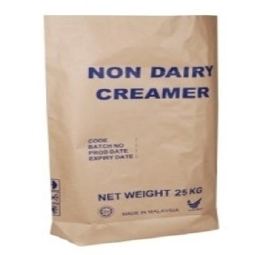 | ||
Similar | ||
Silk almond milk non dairy creamer vanilla flavor product review gluten free soy free
Non-dairy creamers or coffee whiteners are liquid or granular substances intended to substitute for milk or cream as an additive to coffee, tea, hot chocolate or other beverages. They do not contain lactose and therefore are commonly described as not being dairy products, although many contain casein, a milk-derived protein. Dry granular products do not need to be refrigerated and can be used and stored in locations which do not have a refrigerator. Liquid non-dairy creamers should be tightly capped and refrigerated after opening. Some non-dairy creamers contain sweeteners and flavours, such as vanilla, hazelnut or Irish cream. As with other processed food products, low calorie and low fat versions are available for non-dairy creamers.
Contents
- Silk almond milk non dairy creamer vanilla flavor product review gluten free soy free
- History
- Ingredients
- Non food uses
- References
History

Holton "Rex" Diamond did experiments from 1943 to 1945 with using a "[g]elationous form of soybean protein" to make a "soy cream" that would not form curds when mixed with coffee. Diamond's experiments are the first English-language reference to a non-dairy creamer for coffee. In 1950, Melvin Morse and Dick Borne of Presto Foods developed "Mocha Mix Coffee Creamer", which was the first commercial non-dairy creamer and the first product with the term “Coffee Creamer” in the name. Another early commercial powdered creamer was "Pream," first marketed in 1952 and made from dehydrated cream and sugar. It did not dissolve easily because of the protein in the milk.

Six years later, in 1958, the Carnation Company developed a product that easily dissolved in hot liquid because it replaced most of the milk fat with vegetable oil, and reduced the milk protein. The new product was marketed under the Carnation label with the brand name Coffee-Mate. Borden followed suit by launching Cremora non-dairy creamer in 1963. Frank S. Mitchell developed a non-dairy whip topping for Rich Products Corp in 1946. Mitchell also developed a non-dairy coffee creamer, Perx, which was successful in the market.
Ingredients

To replicate the mouthfeel of milk fats, nondairy creamers often contain hydrogenated vegetable-based fats, although nonfat nondairy creamers/whiteners also exist. Other common ingredients include solidified corn syrup and other sweeteners or/and flavourings (such as French vanilla, hazelnut and Irish cream); as well as sodium caseinate, a milk protein derivative (from casein) that does not contain lactose.
The use of a milk derivative prompts some individuals and organisations - such as vegans and Jewish dietary law authorities - to classify the product as "dairy" rather than nondairy. Those who rely on this classification will either not consume the product (e.g. vegans) or will not use or consume it in conjunction with any meat products (e.g. observant Jews). As with other processed food products, low calorie and low fat versions are available for non-dairy creamers.
Non-food uses
As with many other powders, large amounts of powdered non-dairy creamer powder are susceptible to dust explosion when suspended in air. Amateur filmmakers and pyrotechnicians have taken advantage of this property to produce several types of fireball effects. Individuals using powdered non-dairy creamer in the ordinary amounts used in a cup of coffee do not face a risk of dust explosion.
Coffee creamer powder has also been used for creating fake snow in television and movies.
